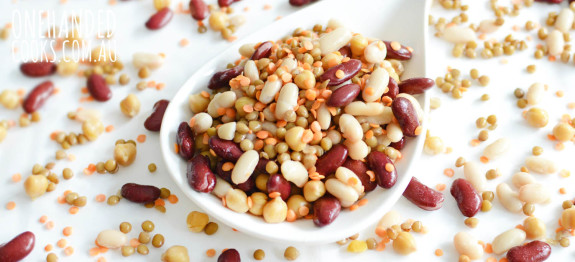Cooking with Legumes
Cooking with Legumes
“What are legumes?” you ask. Legumes, also known as pulses, include all forms of beans and peas. The more commonly known legumes are chickpeas, kidney beans, lentils and cannellini beans. There are also butter beans, soybeans, lima beans, black-eyed beans, haricot (navy) beans, split peas and mung beans. Peanuts, often thought of as a nut, are actually a legume too. You can buy legumes canned, dried, fresh and frozen.
The Grains & Legumes Nutrition Council recommends we eat legumes two to three times every week. They are packed full of nutrients and offer a range of health benefits for both young and old. Legumes are also convenient, versatile and inexpensive making them a valuable addition to the diets of Australian families. Add them to soups and salads, mash them with vegetables, mix with rice, make delicious dips, bulk up casseroles, pies or bolognese sauces with legumes or even roast them for a crunchy snack.
Nutritional benefits
- PROTEIN: Cooked legumes provide about twice as much protein as cereal foods. Legumes don’t contain all the essential amino acids, so including them in the diet together with, rather than instead of, cereal foods will ensure you receive all the amino acids you need.
- CARBOHYDRATE RICH AND LOW GI: Legumes are rich in carbohydrates and have a low glycaemic index (GI) resulting in sustained energy release, which gives children the energy to play and learn.
- HIGH IN FIBRE: Legumes provide about 3.5–9g of fibre, both insoluble and soluble, per 100g of cooked beans, and this contributes to good bowel health and function.
- LOW IN SATURATED FAT: Apart from peanuts and soybeans, legumes are generally low in fat and contain very little of the undesirable saturated fatty acids. Peanuts and soybeans contain predominantly heart healthy monounsaturated and polyunsaturated fatty acids.
- LOW IN SALT: Legumes are naturally low in salt. Prepare dried legumes without salt and rinse canned legumes well to keep their salt content low.
- A SOURCE OF IRON AND ZINC: Iron and zinc are vital nutrients that babies and toddlers need to receive from food from about 6 months of age, as their stores from birth begin to deplete. While the iron in legumes is not easily absorbed, including vitamin C rich foods alongside legumes at mealtimes will maximise iron absorption.
- NUTRIENT RICH: Legumes are a particularly good source of the B group vitamins needed for energy production and release, including folate, thiamine and niacin, as well as calcium and magnesium which are needed for bone health.
- GLUTEN FREE: Legumes are gluten free, making them a valuable and nutritious carbohydrate option for anyone with coeliac disease.
- RICH IN PHYTONUTRIENTS: Legumes contain health promoting plant compounds such as phytoestrogens, lignans and isoflavones, which may play a role in preventing many lifestyle diseases later in life including certain cancers, heart disease and osteoporosis.
Babies and toddlers can benefit too
Currently only 1 in 20 Australian children regularly include legumes in their diet. Since legumes provide protein, iron and zinc, they are a great addition right from the start of eating solids. The Australian Dietary Guidelines note that “pureed and mashed vegetables, including legumes, are important in the diets for infants from around six months of age”. Simply puree or mash with vegetable/meat combinations.
Recommended serves of vegetables, including legumes, for young children
| Age | Serves per day |
| 7–12 months | 1½– 2 (1 serve = 20g) |
| 13–24 months | 2–3 serves (1 serve = 75g) |
| 2–3 years | 2½ serves |
| 4–8 years | 4½ serves |
Role of legumes in the vegetarian diet
During early civilisation legumes were often described as ‘poor man’s meat’. This remains relevant today, as in addition to legumes being a nutrient rich, healthy addition to the diet, they are versatile, convenient and inexpensive, making meals economical for families. The Dietary Guidelines now recommend vegetables as part of the ‘meat and meat alternatives’ food group in addition to the ‘vegetables’ group reflecting their role as a meat substitute.
It is important to note that legumes are low in the essential amino acid methionine. Simply combining legumes with other vegetarian sources of protein including grains, nuts and seeds will help ensure your children receive the right balance of essential amino acids needed for growth and development. Simple examples include enjoying homemade baked beans on wholegrain toast or serving a chickpea curry with rice.
How to cook dried legumes
Cooking legumes ensures they are easily digestible and allows their nutrients to be absorbed.
- Place in a bowl, rinse well, cover with plenty of water and leave to soak overnight
- Drain, place in a large saucepan, cover with water and bring to the boil
- Reduce the heat and gently simmer until tender. The length of cooking time required will depend on the variety of legume.
Note: Lentils and yellow or green split peas don’t require overnight soaking but they do need to be rinsed well before use.
Cooked legumes can be frozen so if you like to prepare dried legumes for your cooking simply cook more than you need and freeze some for later use. Alternatively canned legumes are pre-cooked ready for you to use straight away so there’s no excuse not to use them in your cooking. Just remember to rinse them first – it helps to remove some of the added salt.
More on legumes
10 top tips on how to include legumes in your children’s diet
INSPIRATION: 40+ nutritious legume recipe ideas
This article was first featured in our Autumn/Back To School issue of our Magazine. To find out more about our popular magazines or to purchase online see the links below:





























